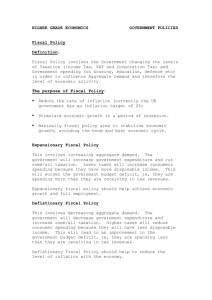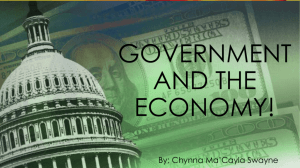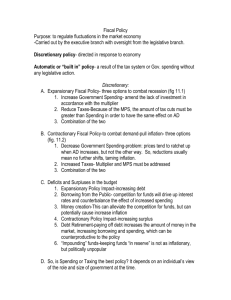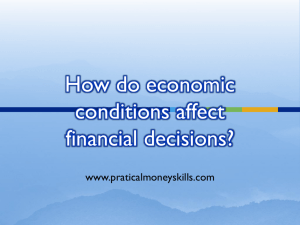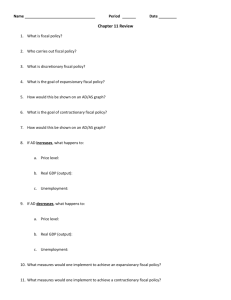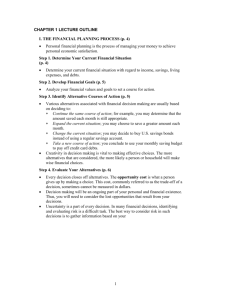Monetary Policy
advertisement
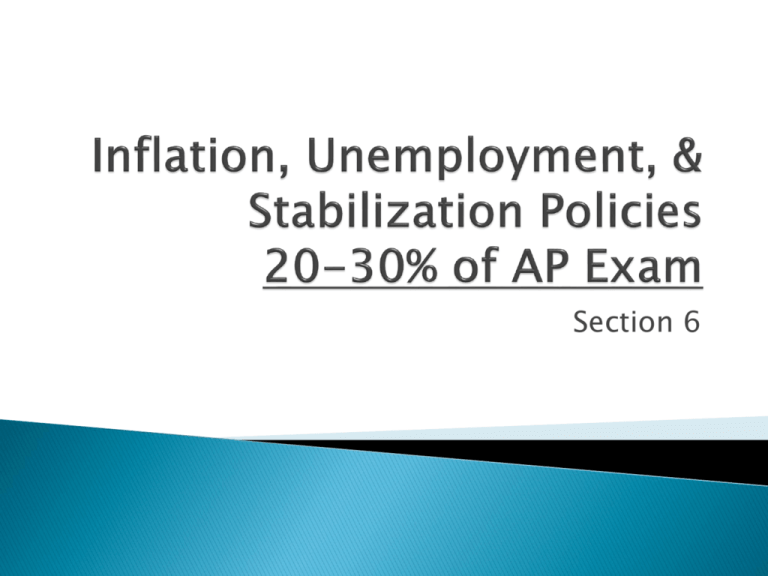
Section 6 A . Fiscal and monetary policies ◦ ◦ ◦ ◦ 1 . Demand-side effects 2 . Supply-side effects 3 . Policy mix 4 . Government deficits and debt B . The Phillips curve ◦ 1 . Short-run and longrun Phillips curves ◦ 2 . Demand-pull versus cost-push inflation ◦ 3 . Role of expectations Module 30 Government decisions about tax rates and spending levels. Two types: ◦ Expansionary – Grows the economy/increases deficit Decrease Taxes Increase Spending Increase transfers ◦ Contractionary – Slows the economy/reduces deficit Increase Taxes Decrease Spending Decrease Transfers The budget balance is the difference between the government’s tax revenue and its spending, both on goods and services and on government transfers, in a given year. ◦ A budget surplus is a positive budget balance and a budget deficit is a negative budget balance. the budget balance (or savings by the government) is defined by: ◦ SGovernment = T - G – TR T is the value of tax revenues G is government purchases of goods and services TR is the value of government transfers. Expansionary Policies reduce the budget balance for the year Contractionary Policies increase the budget balance for the year Expansionary fiscal policy is in order. 3 options: ◦ Cut taxes. ◦ Increase transfers. ◦ Increase government spending. These three policies should increase AD and reverse the recession, but will cause the budget balance to decrease. This means either a smaller surplus or a bigger deficit. Contractionary fiscal policy is in order. 3 options: ◦ Increase taxes. ◦ Decrease transfers. ◦ Decrease government spending. These three policies should decrease AD and reverse the inflation, but will cause the budget balance to increase. This means either a bigger surplus or a smaller deficit. Changes in the budget balance don’t always perfectly reflect changes to fiscal policy. ◦ Just because the balance is decreasing does not mean an expansionary policy is being implemented Two important reasons why it is more complicated. 1. Two different changes in fiscal policy that have equal-size effects on the budget balance may have quite unequal effects on the economy. Example: If government spending increases by $1000, it will have a larger impact on real GDP than a tax decrease of $1000. The budget balance would change by $1000 in each case, but the impacts would be different. 2. Often, changes in the budget balance are themselves the result, not the cause, of fluctuations in the economy. 1. Problems of Timing • Recognition Lag- Congress must react to economic indicators before it’s too late • Administrative Lag- Congress takes time to pass legislation • Operational Lag- Spending/planning takes time to organize and execute (changing taxing is quicker) 2. Politically Motivated Policies • Politicians may use economically inappropriate policies to get reelected. • Ex: A senator promises more public works programs when there is already an inflationary gap. 3. Crowding-Out Effect • • If the government spends more money, and needs to increase borrowing, it will lead to increased interest rates This may “crowd out” business and individuals and decrease investment spending which will in turn reduce economic growth Module 31 Actions taken by the Federal Reserve (or a central bank) to control the supply of money Two types: ◦ Expansionary – Lowers interest rates/grows the economy/increases inflation OMO: Buy bonds Lower Reserve Requirement Lower Discount Rate ◦ Contractionary – Increases interest rates/slows the economy/reduces inflation OMO: Sell Bonds Increase Reserve Requirement Increase Discount Rate Main tool of stabilization policy in practice ◦ Like Fiscal Policy, there are lags BUT Central Banks are able to act more quickly then the government in implementing changes. Fed Funds Rate – Interest rate banks charge other banks for loans (based on Discount Rate) Every 6 weeks, when the FOMC meets, a Target FFR is set. ◦ This target rate is reached through Open Market Operations carried out at the New York branch. This alters the supply of money and allows the FED to drive rates up or down. Expansionary Policy ◦ Lower interest rates = higher investment spending ◦ Higher investment spending = higher GDP ◦ Higher GDP = more consumer spending Contractionary Policy ◦ Higher interest rates = lower investment spending ◦ Lower investment spending = lower GDP ◦ …. Central Banks tend to engage in expansionary policies when real GDP is below potential output (recessionary gap) and contractionary policies when real GDP exceeds potential (inflationary gap) Rule proposed in 1993 by Stanford economist John Taylor ◦ Federal Funds Rate = 1 + (1.5x inflation) + (0.5 X output gap) ◦ This rule is the best way of predicting the Federal Reserve’s behavior when it comes to setting the discount rate Used by some central banks outside the US Central Banks set a target for inflation, and implement a monetary policy to hit that target. Two Advantages ◦ The public knows the objective of the bank for the year ◦ The central bank’s effectiveness can be judged by how close they are to hitting their target yearly Disadvantage ◦ Some argue this is too restrictive and reduces flexibility to act in a crisis. Module 32 In the short-run an increase in the money supply will reduce interest rates, increases investment spending, and increases consumer spending ◦ Output and prices increase as AD shifts right As a result of the expansionary monetary policy, output is now ABOVE potential ◦ This will cause nominal wages to rise, and the SRAS curve to shift to the left THE LONG RUN EFFECT OF AN INCREASE IN THE MONEY SUPPLY IS JUST AN INCREASE IN PRICE LEVELS monetary neutrality: changes in the money supply have no real effects on the economy. In the long run, the only effect of an increase in the money supply is to raise the aggregate price level by an equal percentage. ◦ If MS grows by 50%, prices will grow by 50% ◦ If MS decreases by 25%, prices will drop 25% Economists argue that money is neutral in the long run. A change in the money supply lowers interest rates in the short run However, as price levels rise, the demand for money increases ◦ This shifts the MD curve to the right, bring interest rates back to where they began Module 33 Hyperinflation ◦ Extremely high inflation. Usually caused by a government printing out too much fiat money Cost-push inflation ◦ Inflation caused by a negative supply shock ◦ AKA Stagflation Demand-Pull inflation ◦ Inflation caused by increased demand in the economy Remember: ◦ YP = Potential Output (Assumes economy is at full employment) ◦ Short Run eq left of YP = Recessionary Gap Unemployment is high, inflation is low ◦ Short Run eq right of YP = Inflationary gap Unemployment is low, inflation high Module 34 In the short run there is a negative relationship between unemployment and inflation. ◦ First theorized by economist Alban Phillips Reminder: Supply Shocks ◦ Sudden changes in SRAS Supply Shocks can cause the SRPC to shift ◦ Positive, shifts down ◦ Negative, shifts up Increase in expected inflation shifts the SRPC up In the long run, employment is not impacted by inflation. ◦ Therefore the Long-run Phillips Curve is vertical at the Natural Rate of Unemployment
